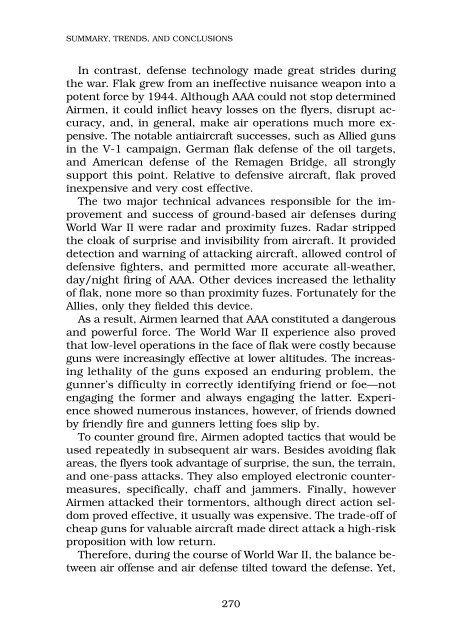Archie to SAM: A Short Operational History of Ground-Based Air ...
Archie to SAM: A Short Operational History of Ground-Based Air ...
Archie to SAM: A Short Operational History of Ground-Based Air ...
You also want an ePaper? Increase the reach of your titles
YUMPU automatically turns print PDFs into web optimized ePapers that Google loves.
SUMMARY, TRENDS, AND CONCLUSIONS<br />
In contrast, defense technology made great strides during<br />
the war. Flak grew from an ineffective nuisance weapon in<strong>to</strong> a<br />
potent force by 1944. Although AAA could not s<strong>to</strong>p determined<br />
<strong>Air</strong>men, it could inflict heavy losses on the flyers, disrupt accuracy,<br />
and, in general, make air operations much more expensive.<br />
The notable antiaircraft successes, such as Allied guns<br />
in the V-1 campaign, German flak defense <strong>of</strong> the oil targets,<br />
and American defense <strong>of</strong> the Remagen Bridge, all strongly<br />
support this point. Relative <strong>to</strong> defensive aircraft, flak proved<br />
inexpensive and very cost effective.<br />
The two major technical advances responsible for the improvement<br />
and success <strong>of</strong> ground-based air defenses during<br />
World War II were radar and proximity fuzes. Radar stripped<br />
the cloak <strong>of</strong> surprise and invisibility from aircraft. It provided<br />
detection and warning <strong>of</strong> attacking aircraft, allowed control <strong>of</strong><br />
defensive fighters, and permitted more accurate all-weather,<br />
day/night firing <strong>of</strong> AAA. Other devices increased the lethality<br />
<strong>of</strong> flak, none more so than proximity fuzes. Fortunately for the<br />
Allies, only they fielded this device.<br />
As a result, <strong>Air</strong>men learned that AAA constituted a dangerous<br />
and powerful force. The World War II experience also proved<br />
that low-level operations in the face <strong>of</strong> flak were costly because<br />
guns were increasingly effective at lower altitudes. The increasing<br />
lethality <strong>of</strong> the guns exposed an enduring problem, the<br />
gunner’s difficulty in correctly identifying friend or foe—not<br />
engaging the former and always engaging the latter. Experience<br />
showed numerous instances, however, <strong>of</strong> friends downed<br />
by friendly fire and gunners letting foes slip by.<br />
To counter ground fire, <strong>Air</strong>men adopted tactics that would be<br />
used repeatedly in subsequent air wars. Besides avoiding flak<br />
areas, the flyers <strong>to</strong>ok advantage <strong>of</strong> surprise, the sun, the terrain,<br />
and one-pass attacks. They also employed electronic countermeasures,<br />
specifically, chaff and jammers. Finally, however<br />
<strong>Air</strong>men attacked their <strong>to</strong>rmen<strong>to</strong>rs, although direct action seldom<br />
proved effective, it usually was expensive. The trade-<strong>of</strong>f <strong>of</strong><br />
cheap guns for valuable aircraft made direct attack a high-risk<br />
proposition with low return.<br />
Therefore, during the course <strong>of</strong> World War II, the balance between<br />
air <strong>of</strong>fense and air defense tilted <strong>to</strong>ward the defense. Yet,<br />
270
















